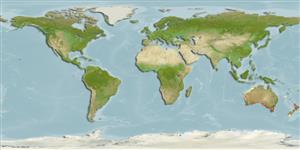>
Gobiiformes (Gobies) >
Gobiidae (Gobies) > Gobiinae
Etymology: Callogobius: Greek, kalos, kallos = beautiful + Latin, gobius = gudgeon (Ref. 45335).
More on authors: Ramsay & Ogilby.
Environment: milieu / climate zone / depth range / distribution range
पारिस्थितिकी
समुद्री; खारा प्रवाल-भित्ति संयुक्त. Temperate
Indo-West Pacific: Widespread in southern Australia, from New South Wales to South Australia, including Tasmania.
आकार / वज़न / Age
Maturity: Lm ? range ? - ? cm
Max length : 14.0 cm TL पुल्लिंग / अलिंग; (Ref. 9002)
Found in shallow rocky reefs, including estuaries (Ref. 9002). Very secretive, under rocks or in narrow ledges (Ref. 9002).
Life cycle and mating behavior
परिपक्व अवधि | पुनरुत्पत्ति | मछलीऔ का अंडे देना | अंडे | Fecundity | लार्वा
Kuiter, R.H., 1993. Coastal fishes of south-eastern Australia. University of Hawaii Press. Honolulu, Hawaii. 437 p. (Ref. 9002)
IUCN Red List Status (Ref. 130435)
Threat to humans
Harmless
Human uses
अधिक जानकारी
आम नामउपशब्दचपायचयपरभक्षीईकोटोकसीकोलौजीपुनरुत्पत्तिपरिपक्व अवधिमछलीऔ का अंडे देनाSpawning aggregationFecundityअंडेEgg development
Age/Size
बाढ़
Length-weight
Length-length
Length-frequencies
मौरफोमैटरिक्स
आकृति विज्ञान
लार्वा
लारवल गतिकी
भर्ती
बहुतायत
BRUVS
संदर्भजलीयकृषिजलीयकृषि रूपरेखाखींचआनुवंशिकीElectrophoresesहैरेटिबिलटीबीमारीप्रक्रमणNutrientsMass conversion
सहयोगीयोतस्वीरेStamps, Coins Misc.ध्वनिसिगुयटिरारफ्तारतैरने के प्रकारगिल क्षेत्रOtolithsदिमागदृष्टि
साधन
Special reports
Download XML
इंटरनेट स्रोत
Estimates based on models
Preferred temperature (Ref.
123201): 13.7 - 23.3, mean 17.6 °C (based on 369 cells).
Phylogenetic diversity index (Ref.
82804): PD
50 = 0.5000 [Uniqueness, from 0.5 = low to 2.0 = high].
Bayesian length-weight: a=0.00912 (0.00295 - 0.02818), b=2.98 (2.72 - 3.24), in cm total length, based on LWR estimates for this (Sub)family-body shape (Ref.
93245).
Trophic level (Ref.
69278): 3.4 ±0.4 se; based on size and trophs of closest relatives
लौटाव (Ref.
120179): ऊंचा, न्यूनतम जनसंख्या दुगनी समय अवलागत 15 महीने। (Preliminary K or Fecundity.).
Fishing Vulnerability (Ref.
59153): Low vulnerability (10 of 100).
Nutrients (Ref.
124155): Calcium = 38.4 [12.7, 81.4] mg/100g; Iron = 0.237 [0.098, 0.515] mg/100g; Protein = 18.5 [16.5, 20.3] %; Omega3 = 0.234 [0.095, 0.537] g/100g; Selenium = 5.01 [1.70, 15.43] μg/100g; VitaminA = 72.8 [14.5, 352.3] μg/100g; Zinc = 1.05 [0.61, 1.78] mg/100g (wet weight);
